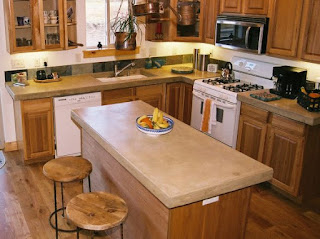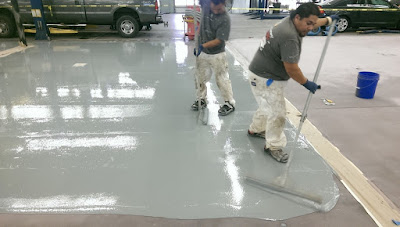 Concrete is a strong, porous material where water and other substances can penetrate. Typically, concrete becomes damaged when this occurs. Water is a liquid substance that is needed for many reasons. However, concrete is damaged when water penetrates and freezes in cold temperatures. Additionally, some harsh chemicals can damage concrete underneath the surface that is hidden to the naked eye. Cosmetic fixes can improve the look of the surface, but the stability of the concrete is compromised.
Concrete is a strong, porous material where water and other substances can penetrate. Typically, concrete becomes damaged when this occurs. Water is a liquid substance that is needed for many reasons. However, concrete is damaged when water penetrates and freezes in cold temperatures. Additionally, some harsh chemicals can damage concrete underneath the surface that is hidden to the naked eye. Cosmetic fixes can improve the look of the surface, but the stability of the concrete is compromised.Fortunately, epoxy floor paint offers a solution to the dangers harmful substances present to concrete. Hiring professional epoxy installers will ensure proper coatings are applied based on surface type. Acting as a sealant, epoxy coatings prevent the penetration of water and other harsh chemicals. This adds years to the life of driveways, patios, basement floors or commercial floorings.
In addition to durability, a concrete floor epoxy coating can be aesthetically pleasing with the right mixture of shine or color. Professional epoxy contractors can help customer’s select vibrant colors or pastel shades based on their needs. Deciding which one to choose with the assistance of contractors also depends on how the flooring is used.
Some sealants are applied to treat a concrete surface, while others penetrate the concrete to provide inner protection. In many situations, a penetrating sealant is preferred because of the additional layer of protection.
 There are also breathable and non-breathable concrete epoxy paint. Breathable sealants work best on concrete slab that does not have a vapor barrier. Water is unable to evaporate and causes moisture build-up. Breathable sealants allow evaporation with protection for the top concrete surface from more moisture. Non-breathable sealants do the opposite where damage occurs to the concrete foundation over time.
There are also breathable and non-breathable concrete epoxy paint. Breathable sealants work best on concrete slab that does not have a vapor barrier. Water is unable to evaporate and causes moisture build-up. Breathable sealants allow evaporation with protection for the top concrete surface from more moisture. Non-breathable sealants do the opposite where damage occurs to the concrete foundation over time.Epoxy Floor Coating can also apply different types of sealant finishes. A simple fix to protect the driveway is using a clear sealant with very little gloss on the surface. However, a sealant for the patio might require a glossy concrete coating. This offers a shiny finish and an aesthetically pleasing look during a summer cookout.
This type of coating for the patio works even better on stamped or stained concrete. High gloss sealants are perfect for this purpose. The array of colors available can easily turn a drab piece of concrete into a beautiful landscape.
When choosing the right sealant, it is important to follow the instruction of professional epoxy contractors. These professional experts determine the perfect weather conditions for applying coatings to outdoor concrete surfaces. They are also experienced in matching customer needs with manufacturer guidelines to make the best recommendations. This ensures a safe application and an effective result that does not require a do-over within six months.
 They also understand the importance of preparing the concrete before applying the sealant. New concrete might require nearly one month of curing before a good sealant is applied.
They also understand the importance of preparing the concrete before applying the sealant. New concrete might require nearly one month of curing before a good sealant is applied. In some cases, concrete sealants need to be reapplied as part of periodic maintenance. This increases the longevity of protection and appearance that is affected by heavy foot or vehicle traffic. Selecting the right sealant for Epoxy Floor Coating surfaces is the difference between having something beautiful and long-lasting from something that is short-lived.


